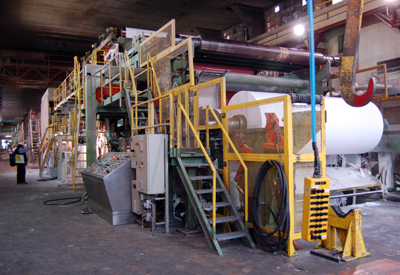Steam Systems in Pulp & Paper Mills
Pulp, paper, and paperboard mills accounted for about 15% of total manufacturing energy use in the U.S.in 2005. Energy is widely used for processes such as running motors and fans, providing compressed air, processing pulp, and drying paper. Steam is a significant utility used in pulp and paper facilities, nationally estimated to be approximately 43% of the total energy demand. Recovery of pretreatment steam during pulping and steam for drying is paramount for reusing energy. While improvements to and maintenance of boilers, insulation of steam and condensate lines, and exhaust heat recovery efforts can lead to approximately 14% energy savings in steam generating systems. Pinch analysis can identify additional thermal savings throughout a mill’s infrastructure. This type of analysis identifies temperature and flow volume differences between supply streams and demand streams that where steam heat can be applied in the most productive way and waste heat can be captured..
Several technologies offer the potential to improve steam use efficiency:
- Recycle low pressure steam. Steam from mechanical pulping can be used in the paper machine dryer section or chip injection by utilizing a heat pump.
- Retrofit the drying section with infrared (IR) dryers. IR dryers direct heat onto the paper web and can save about 35% of natural gas use; however, the electrical heaters require additional electrical energy.
- Retrofit the press section with hot cylinders. Use hot cylinders to impulse heat the web before it enters the typical paper machine (PM) drying section.
- Retrofit the drying section with a microwave drying system. Cross or machine directional microwaves can direct heat onto the paper web
- Retrofit the dryer section with a Condebelt dryer. This continuous moving hot steel band is heated by steam or directly heated and could replace typical drying cylinders for paper weights less than 150 g/m2.
- Retrofit the drying section with air ingement drying. Using either gas burners or steam and amplified compressed air, blow hot air across the web to save 10-15% of steam requirements; however this method increases facility electrical demand up to 5%.
- Fabricate a closed hood surrounding the Paper Machine. Also, optimize ventilation inside the unit reduce thermal energy demands for drying and reduce the volume of air heated. Investment costs are moderate and can yield savings of nearly 8% of natural gas use. Often this hood configuration is coupled with airless drying.
- Pre-heat pulp with a steam shower. Pre-heating pulp can reduce the load on the dryer, reduce residence time in the nip, and thus allow increases the machine speed while savings 6% of natural gas use.
- Improve chip screening to remove ‘thick’ wood chips. Doing so can save up to 4% of natural gas use by lowering steam residence times.
Moisture profiling the sheet with IR sensors at the headbox can help control sheet moisture content precisely and reduce drying inconsistencies. The Lawrence Berkeley National Laboratory estimates this reduces thermal energy needs by 7%.
